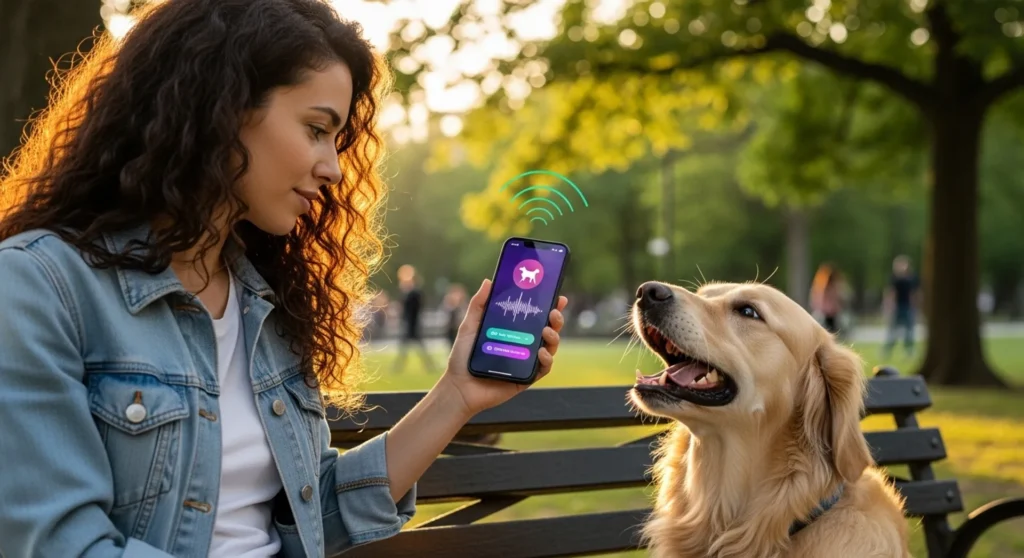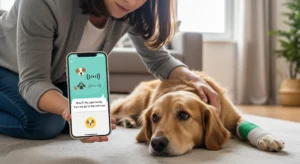For centuries, dog owners have wondered what their furry companions are trying to say. Every bark, whine, or tail wag feels like a coded message waiting to be unlocked. Thanks to advances in artificial intelligence, pet translator technology may soon turn this dream into reality. But how reliable is this tech, and what does it mean for everyday dog owners and sitters?
The Science Behind Pet Translator Technology
Pet translators aim to interpret canine sounds and body language into human speech. Some AI systems are trained on thousands of dog barks, while others analyze subtle body signals like posture or ear movement. A recent survey reported that nearly 40% of dog owners are interested in pet translator devices to better understand their pups’ emotions.
Researchers suggest that barks and growls may carry consistent emotional cues. For example, a sharp, repetitive bark may indicate alertness, while a low growl may signal discomfort. Translators attempt to match these patterns with likely meanings, providing owners with a glimpse into their dog’s mood or needs.
Potential Benefits of Pet Translator Devices
1. Improved Bond Between Owners and Dogs
Understanding what your dog is “saying” could deepen your emotional connection. If a translator indicates your dog is anxious when left alone, you can take steps to comfort them — such as arranging a sitter or using enrichment toys.
2. Reduced Stress During Dog Sitting
Professional sitters already read canine body language carefully. However, a translator device could give additional insights. When paired with preparation advice like how to prepare your dog for a successful dog sitting experience, sitters may anticipate stress points before they escalate.
3. Safer Pet Care
Dogs often mask pain or illness. A translator that flags unusual vocalizations might encourage quicker trips to the vet. While not a substitute for professional care, the technology may help owners detect problems early, much like pet sitting safety practices emphasize careful monitoring.
Challenges and Limitations
Despite the excitement, pet translator technology is still in its infancy. Here are some challenges to keep in mind:
- Accuracy Issues: Dog communication is complex and context-specific. A bark may mean excitement in one situation and fear in another.
- Overreliance: Owners may take translator readings at face value instead of observing natural cues.
- Ethical Questions: Is it truly possible to “translate” emotions into words without oversimplifying?
Dog sitting experts stress that technology should support, not replace, careful human observation. Resources like the top 5 questions to ask a dog sitter remain essential to ensuring quality care.
How Pet Translators Affect Dog Sitting
As these devices become more available, they may change how dog sitting services operate:
- Enhanced Reports: Sitters could share not only updates on meals and walks but also emotional “translations” of how the dog felt during the day.
- Better Travel Support: For owners worried about separation, combining translators with dog sitting services that ease travel plans may provide reassurance.
- Custom Care Plans: Dogs flagged as anxious could receive more one-on-one time or extra comfort measures.
Expert Opinions on Pet Translator Feasibility
According to veterinarians, while pet translators are promising, they should be seen as supplemental tools. Dogs communicate with a blend of sound, smell, and movement, which technology may never fully replicate. Still, as PetMD explains, understanding bark patterns can reveal much about a dog’s emotional state. Translators may simply make this knowledge more accessible to everyday owners.
Tips for Dog Owners Considering Pet Translator Tech
- Choose Reputable Devices: Research companies with strong AI development backgrounds and veterinary endorsements.
- Pair with Observation: Don’t ignore natural cues like tail movement, appetite, or sleep patterns.
- Use for Training: Translators may help identify when dogs are confused or stressed during learning sessions.
- Combine with Professional Care: Remember that tools never replace the knowledge of a skilled sitter. See the ultimate guide to dog sitting services for more on what professional care includes.
The Future of Dog-Human Communication
Looking ahead, pet translators may integrate with smart collars and health monitors, giving owners a complete picture of their pet’s needs. Imagine receiving alerts like “Bella is anxious” or “Max may need more water.” This kind of proactive communication could revolutionize dog sitting and home care alike.
At the same time, industry experts caution that translation apps may be marketed faster than the science supports. Owners should view them as experimental tools, not guaranteed solutions. The best care still comes from attention, compassion, and professional oversight.
Conclusion
Pet translator technology taps into every dog owner’s dream of deeper communication. While not yet perfect, it offers promising benefits for building stronger bonds, enhancing dog sitting experiences, and detecting wellness concerns earlier. Used wisely, it can complement — not replace — the love and expertise you already bring to your pet’s care.
If you’re interested in combining cutting-edge tools with compassionate pet care, remember that nothing replaces the value of a skilled sitter who treats your dog like family. Learn more about when to consider a professional dog sitter and how to make your pup’s next stay stress-free.





